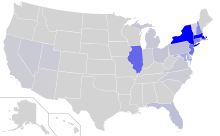
Back Ελληνοαμερικανοί Greek Inmigración griega en Estados Unidos Spanish آمریکاییهای یونانیتبار Persian Amerikankreikkalaiset Finnish Gréco-Américains French Yunani Amerika ID Greco-americani Italian 그리스계 미국인 Korean Greco-americanos Portuguese Греки в США Russian
 | |
| Total population | |
|---|---|
| 1,208,000 (0.4% of the U.S. population)[1][2] [3] | |
| Regions with significant populations | |
| New York City/North Jersey • Baltimore • Chicago • Metro Detroit • San Francisco Bay Area • Los Angeles • Tampa/Tarpon Springs • Philadelphia • Houston • Salt Lake City • Charlotte, North Carolina | |
| Languages | |
| Religion | |
| Christianity, predominantly Greek Orthodox, other religions, Judaism |
| Part of a series on |
| Greeks |
|---|
 |
|
History of Greece (Ancient · Byzantine · Ottoman) |
Greek Americans (Greek: Ελληνοαμερικανοί Ellinoamerikanoí [eliˌno.amerikaˈni] or Ελληνοαμερικάνοι Ellinoamerikánoi [eliˌno.ameriˈkani])[4] are Americans of full or partial Greek ancestry. The lowest estimate is that 1.2 million Americans are of Greek descent while the highest estimate suggests over 3 million.[3] According to the US census, 264,066 people older than five spoke Greek at home in 2019.[5]
Greek Americans have the highest concentrations in the New York City,[6][7][8] Boston,[9] and Chicago[10] regions, but have settled in major metropolitan areas across the United States. In 2000, Tarpon Springs, Florida, was home to the highest per capita representation of Greek Americans in the country (just over 10%). The United States is home to the largest number of Greeks outside of Greece, followed by Cyprus and Australia.
Within the New York City region, Astoria, Queens contains an abundant Greek community and an official Greektown. Officially city-designated Greektowns exist in Chicago, Detroit, and Tarpon Springs in the Tampa area. Greek community enclaves have been found in other metropolitan areas, such as in the San Francisco Bay Area, Los Angeles, Philadelphia, and rural areas such as Campbell, Ohio are home to Greek enclaves. There are also strong Greek communities in Boston, the Salt Lake Valley, and in North Carolina, especially Charlotte and Asheville areas.
- ^ "Table B04006 - People Reporting Ancestry - 2019 American Community Survey 5-Year Estimatestrue". United States Census Bureau. Retrieved December 18, 2024.
- ^ "U.S. Relations With Greece - Bilateral Relations Fact Sheet". United States Department of State. Retrieved February 5, 2021.
- ^ a b "Total Ancestry Reported". United States Census Bureau. 2010. Archived from the original on January 18, 2015. Retrieved December 4, 2014.
- ^ "ελληνοαμερικάνος in Λεξικό της κοινής νεοελληνικής". Dictionary of Standard Modern Greek. Institute of Modern Greek Studies (Manolis Triantafyllidis Foundation). 1998. Retrieved February 5, 2021.
- ^ Dietrich, Sandy; Hernandez, Erik (September 1, 2022). "Language Use in the United States: 2019". United States Census Bureau.
- ^ "Selected Population Profile in the United States 2010-2012 American Community Survey 3-Year Estimates". United States Census Bureau. Archived from the original on February 12, 2020. Retrieved December 13, 2014.
- ^ "Yearbook of Immigration Statistics: 2012 Supplemental Table 2". U.S. Department of Homeland Security. Retrieved April 1, 2013.
- ^ "Yearbook of Immigration Statistics: 2009 - Supplemental Table 2". Retrieved April 24, 2010.
- ^ "Selected Population Profile in the United States 2010-2012 American Community Survey 3-Year Estimates". United States Census Bureau. Archived from the original on February 12, 2020. Retrieved December 13, 2014.
- ^ "Selected Population Profile in the United States 2010-2012 American Community Survey 3-Year Estimates". United States Census Bureau. Archived from the original on February 12, 2020. Retrieved December 13, 2014.